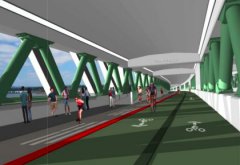
commitment that it will stay
that way.
As we reported last month, the new I-5 bridge design that has won most favor with Columbia River Crossing (CRC) project staffers and advisers is a “stacked” bridge with the bike and pedestrian path underneath.
Below-deck bikeways have typically been shunned by bike advocates because of security and maintenance concerns. The Multnomah County Bike and Ped Advisory Committee, for instance, rejected a similar design option for the Sellwood Bridge. In a recent story, advocate Michelle Poyourow with the Bicycle Transportation Alliance (BTA) said, “Something underneath we’re concerned about, not just because an absence of safety but a feeling of safety… I fear it will go underused.”

However, a two-bridge design with the bike/ped path underneath still came out on top after a 42 criterion design analysis (by the CRC Pedestrian and Bicycle Advisory Committee) of the three bridge options (the other options were three bridges and two bridges with the bike/ped path on top).
“The maintenance and the placement of the path under cover are inseparable in our minds.”
— Michelle Poyourow, BTA
The committee also issued a draft outline of their recommendations for how CRC planners should deal with security and maintenance measures on such a design. They call for security cameras, regular police patrols, bright LED lighting, call boxes, and so on (see full list below).
Poyourow says that their support of the below deck path design is wholly dependent on a commitment to these maintenance guidelines. She says they want a commitment not just from the CRC’s Project Sponsors Council (PSC), but from an agency or government that will exist well into the future.
In an email about the maintenance guidelines, Poyourow wrote:
“Without a commitment… to maintain and operate an under-bridge path to the standards laid out by the CRC PBAC, we do not support the under bridge path… The maintenance and the placement of the path under cover are inseparable in our minds.”
Here is the full text of the PBAC’s Recommendation for a Maintenance and Security Program
The best and most effective method of enhancing maintenance and security is to design a functional facility that is inviting to and well used by the general public. Design principals that provide natural surveillance, territorial reinforcement, and natural access control will minimize on-going maintenance and security requirements. A reliable and funded program will be required. The program must recognize that a poorly maintained facility could undermine the value of good design.
The maintenance and security program shall include, but not be limited to, the following:
- Identification of reliable funding sources and responsible parties for maintenance and security
- Commitment of reliable funding sources and responsible parties for maintenance and security
- Demand responsive and prompt facility management and maintenance
- Opportunities to “program the space” and support activity (e.g., kiosks, overlooks, vendor opportunities) to provide “eyes on the pathway”
- Ensure 24 hours a day, seven days a week pedestrian and bicycle access to and across the bridge and its connecting pathways
- Visible and regular on-site monitoring by law enforcement officers or security staff
- Security cameras monitored by law enforcement officers or security staff
- Call boxes to enable bridge users to report immediate maintenance needs and security concerns
- Efficient, sufficient, vandal-proof, no glare and dark skies compliant clear, crisp, white LED lighting
- Clearly posted laws and ordinances
- Advance notification and posting of maintenance closures and detours
- Citizen and volunteer participation shall be encouraged for future maintenance, operations and programming
The PBAC recommends that the above outline of elements form the basis for a detailed maintenance and security program that is regularly reviewed, performance-based and contains measurable metrics.
In other CRC news, economist Joe Cortright penned an editorial in Saturday’s Oregonian where he called it, “a bridge we don’t need and can’t afford.” Then, The Oregonian Editorial Board answered with a piece in the Sunday paper which stated, “Replacing the bridge is imperative not just for our region, but for improving traffic flow along a vital national freight corridor.”

